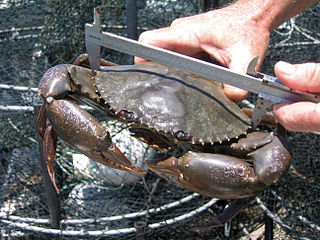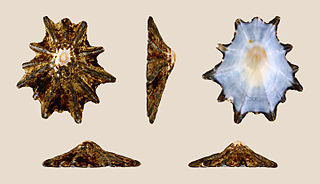
A tide pool or rock pool is a shallow pool of seawater that forms on the rocky intertidal shore. These pools typically range from a few inches to a few feet deep and a few feet across. Many of these pools exist as separate bodies of water only at low tide, as seawater gets trapped when the tide recedes. Tides are caused by the gravitational pull of the sun and moon. A tidal cycle is usually about 25 hours and consists of one or two high tides and two low tides.

Scylla serrata is an ecologically important species of crab found in the estuaries and mangroves of Africa, Australia, and Asia. In their most common forms, their shell colours vary from a deep, mottled green to very dark brown.

The intertidal zone or foreshore is the area above water level at low tide and underwater at high tide; in other words, it is the part of the littoral zone within the tidal range. This area can include several types of habitats with various species of life, such as sea stars, sea urchins, and many species of coral with regional differences in biodiversity. Sometimes it is referred to as the littoral zone or seashore, although those can be defined as a wider region.

Intertidal ecology is the study of intertidal ecosystems, where organisms live between the low and high tide lines. At low tide, the intertidal is exposed whereas at high tide, the intertidal is underwater. Intertidal ecologists therefore study the interactions between intertidal organisms and their environment, as well as between different species of intertidal organisms within a particular intertidal community. The most important environmental and species interactions may vary based on the type of intertidal community being studied, the broadest of classifications being based on substrates—rocky shore and soft bottom communities.

Marine ecosystems are the largest of Earth's aquatic ecosystems and exist in waters that have a high salt content. These systems contrast with freshwater ecosystems, which have a lower salt content. Marine waters cover more than 70% of the surface of the Earth and account for more than 97% of Earth's water supply and 90% of habitable space on Earth. Seawater has an average salinity of 35 parts per thousand of water. Actual salinity varies among different marine ecosystems. Marine ecosystems can be divided into many zones depending upon water depth and shoreline features. The oceanic zone is the vast open part of the ocean where animals such as whales, sharks, and tuna live. The benthic zone consists of substrates below water where many invertebrates live. The intertidal zone is the area between high and low tides. Other near-shore (neritic) zones can include mudflats, seagrass meadows, mangroves, rocky intertidal systems, salt marshes, coral reefs, lagoons. In the deep water, hydrothermal vents may occur where chemosynthetic sulfur bacteria form the base of the food web.

The Asterinidae are a large family of sea stars in the order Valvatida.

Ecklonia radiata, commonly known as golden kelp, common kelp, spiny kelp or leather kelp, is a species of kelp found in the Canary Islands, the Cape Verde Islands, Madagascar, Mauritania, Senegal, South Africa, Oman, southern Australia, Lord Howe Island, and New Zealand. In Australia, E. radiata forms the backbone of the Great Southern Reef, a system of interconnected kelp reefs that spans the coastline of southern Australia, underpinning biodiverse and productive ecosystems, and supporting valuable ecosystem services.

Pisaster ochraceus, generally known as the purple sea star, ochre sea star, or ochre starfish, is a common seastar found among the waters of the Pacific Ocean. Identified as a keystone species, P. ochraceus is considered an important indicator for the health of the intertidal zone.
The crumb-of-bread sponge is a species of sea sponge in the class Demospongiae.

Scutellastra longicosta, the long-spined limpet or the duck's foot limpet, is a species of true limpet, a marine gastropod mollusk in the family Patellidae, one of the families of true limpets. It is native to the coasts of South Africa where it is found on the foreshore. It cultivates a species of crustose brown algae in a "garden".

Pyura stolonifera, commonly known in South Africa as "red bait", is a sessile ascidian, or sea squirt, that lives in coastal waters attached to rocks or artificial structures. Sea squirts are named for their habit of squirting a stream of water from their exhalant siphons when touched at low tide.

Anthothoe chilensis, or striped anemone, is a species of sea anemones in the family Sagartiidae.
Parvulastra parvivipara is a very small species of starfish in the family Asterinidae. It is a viviparous species and gives birth to live young. It lives in rock pools on intertidal granite rocks in a limited area of South Australia.

Heliaster kubiniji is a species of starfish in the order Forcipulatida. It is commonly known as the gulf sun star, the common sun star or estrella de mar de golfo and it occurs in the intertidal zone of the Pacific coast of California, Mexico and Nicaragua.
Cape Byron Marine Park is one of four marine parks in New South Wales, Australia, and is the most recently sanctioned. The Cape Byron Marine Park is located in Northern NSW and extends 37 kilometres (23 mi) from the Brunswick River to Lennox Head. The marine park extends out to 3 nautical miles which dictates the border between state and federal jurisdiction. The marine park covers an area of 220 square kilometres (85 sq mi) and includes a variety of marine terrain including beaches, rocky shores, open ocean and the tidal waters of the Brunswick River and its tributaries, the Belongil Creek and Tallow Creek. The Cape Byron Marine Park was declared in 2002 and the zoning plan was implemented in April 2006. Of the 15 distinct marine ecosystems identified within the Tweed-Moreton bioregion, the Cape Byron Marine Park supports 10 of these.
Parvulastra vivipara, the Tasmanian live-bearing seastar, is a tiny, uniformly orange-yellow seastar, up to 15 mm (0.6 in) across. The species usually has five short arms and is a rounded, pentagon shape. Morphological variation is common and three, four or six arms are occasionally present. It is endemic to coastal waters in southeast Tasmania.
The Helderberg Marine Protected Area is a small marine conservation area on the north-eastern side of False Bay in the Western Cape province of South Africa, It lies between the mouths of the Lourens River in the Strand, and the Eerste River in Macassar.
The Hluleka Marine Protected Area is an inshore conservation region in the territorial waters of the Eastern Cape province of South Africa.














